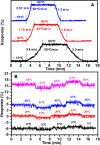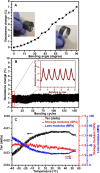Fully Printed Flexible Polystyrene/Graphite-Based Temperature Sensor with Excellent Properties for Potential Smart Applications
- PMID: 39926534
- PMCID: PMC11800034
- DOI: 10.1021/acsomega.4c09548
Fully Printed Flexible Polystyrene/Graphite-Based Temperature Sensor with Excellent Properties for Potential Smart Applications
Abstract
This study presents an innovative temperature sensor based on a thermistor nanocomposite of graphite (Gt) and polystyrene (PS). The sensor exhibited notable thermal stability and film integrity, offering two distinct linear response regions within the tested temperature range of -10 to 60 °C. It demonstrated a sensitivity of 0.125% °C-1 between -10 and 10 °C, followed by another linear response with a sensitivity of 0.41% °C-1 from 20 to 60 °C. Furthermore, it exhibited a response/recovery time of 0.97/1.3 min at a heating/cooling rate of 60 °C min-1. The sensor maintained minimal baseline drift even when subjected to varying humidity levels. We assessed its mechanical flexibility and stability for hundreds of bending cycles at a bending angle of 30°, adapting to dynamic environmental conditions. The sensor's thermomechanical test (response to mechanical stress under temperature fluctuations) underscored its adaptability over a temperature range of -10 to 60 °C. Notably, it displayed excellent chemical stability, maintaining consistent performance when subjected to harsh environmental conditions like exposure to corrosive gases and prolonged immersion in tap water. Real-world tests demonstrated its practical utility, including precise temperature measurements in solid objects and breath temperature monitoring. These findings suggest promising applications in healthcare, environmental monitoring, and various IoT applications.
© 2025 The Authors. Published by American Chemical Society.
Conflict of interest statement
The authors declare no competing financial interest.
Figures








References
-
- Phadkule S. S.; Sarma S. Progress in Nanocomposite Based Flexible Temperature Sensors: A Review. Meas.: Sens. 2023, 27, 10069210.1016/j.measen.2023.100692. - DOI
-
- Dos-Reis-Delgado A. A.; Carmona-Dominguez A.; Sosa-Avalos G.; Jimenez-Saaib I. H.; Villegas-Cantu K. E.; Gallo-Villanueva R. C.; Perez-Gonzalez V. H. Recent Advances and Challenges in Temperature Monitoring and Control in Microfluidic Devices. Electrophoresis 2023, 44 (1–2), 268–297. 10.1002/elps.202200162. - DOI - PMC - PubMed
LinkOut - more resources
Full Text Sources
Miscellaneous
